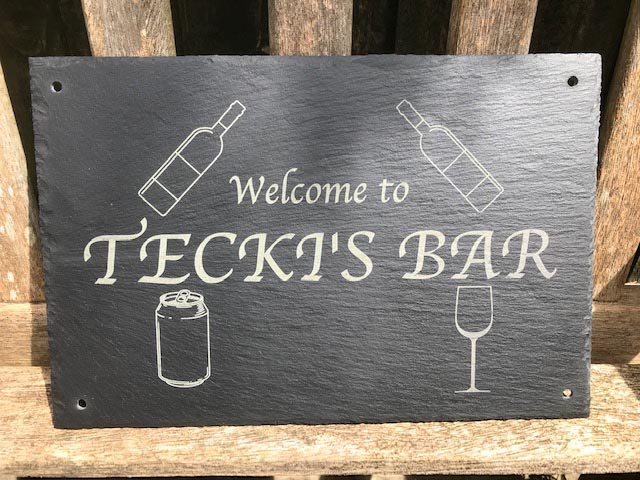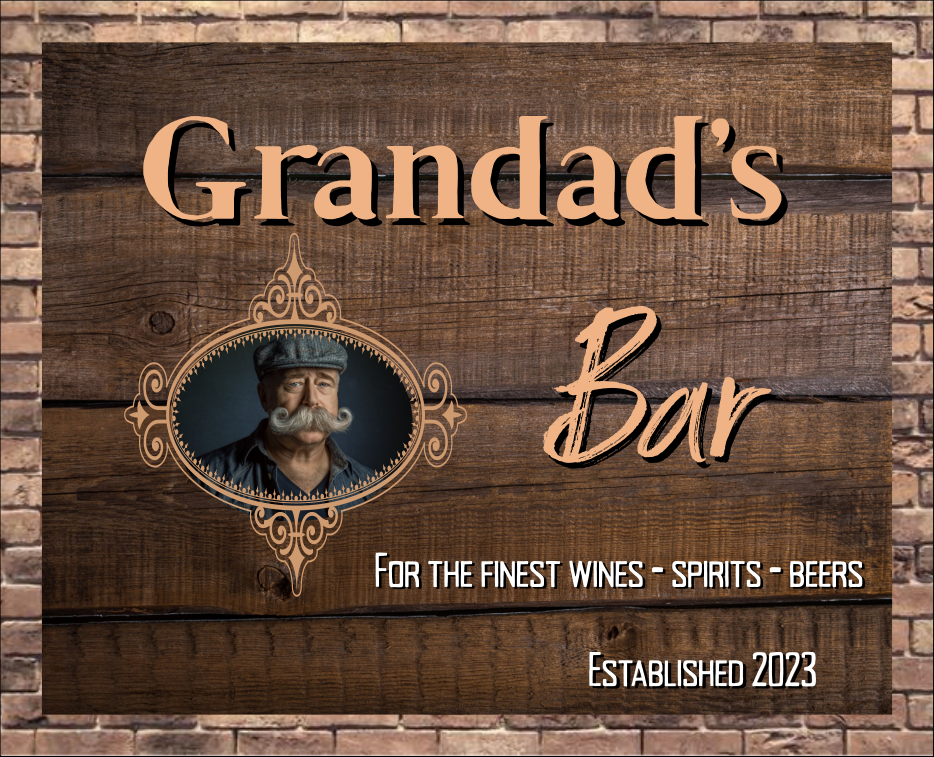Bar signs differ significantly in regards to location, and also their style, function, and placement are tailored to ensure their effectiveness in specific regions. Below is a breakdown on how bar signs differ based on the location they're located: Signs for the exterior
Use: To create an identity for your establishment and to attract new patrons.
Features: Large and eye-catching. Sometimes, the lights are lit in the evening to increase visibility.
Materials: Weather-resistant, durable materials such as neon and vinyl.
Examples: The main bar sign, the logo sign, and the marquee that is above the entryway.
2. Entrance Signs
Welcome patrons to the store and give them basic information.
Features: Clear design, with branding and other elements.
Materials: Wood, steel, or signs with lights.
Examples "Welcome to the shop" signs and operating hours, or announcements about special events.
3. Interior Wall Signs
The purpose of the sign is to add style, convey details, and create an atmosphere.
Features: Available in various sizes and styles to match any interior decor.
Materials: Wood, metal, chalkboard, acrylic.
Examples: Thematic decor signs menu boards, thematic decor signs, and inspirational quotes.
4. The bar's signboards are visible
The aim of this is to highlight the key elements in the bar, such as its name, signature cocktails and the latest specials.
Highlights: It is well-lit and visible which makes it a prime zone.
Materials: LED, neon Digital display, chalkboard or any other materials.
Examples include bar name signs and drink specials boards.
5. Wall and Ceiling Signs
Use for: Information on directions or to improve the decor.
Highlights: Suspended ceiling, accessible from various angles.
Materials: Lightweight, lightweight materials like foam board, metal or acrylic.
For example: hanging decorative signs and themed props.
6. Tabletop Signs
Use: Give patrons details that are specific to their table.
Features The font is small and easy to read at a distance.
Materials The materials are: wood laminated with acrylic or paper.
Examples include menus for drinks, table numbering promotional cards, and QR code labels.
7. Restroom Signs
Utilization: To clearly indicate the location and type of restrooms.
Most often, they are accompanied by very precise symbols and text.
Materials: Metal, plastic, wood.
Examples: Men's and female restroom signs, non-sex restroom signs.
8. Directional Signs
The purpose of the sign is to guide patrons to various areas within the bar.
It is easy to read labels and arrows.
Materials: Metal, acrylic, wood.
Examples: Signs that point to restrooms, exits and seating places.
9. Window Signs
The objective of a poster is to draw the attention of passers-by and inform them about your bar.
Specifications: Visible and usually includes lighting.
Materials: Vinyl decals, neon, LED.
Examples: Advertisements, promotional signs, event announcements and operating hours.
10. Signs for Promotion and Event
The purpose of this newsletter is to inform patrons about special and seasonal promotional offerings.
Highlights: Attractive and often temporary.
Materials: Vinyl, foam board, chalkboard.
For example: event posters, promotional banners and chalkboard-themed specials.
Location Specific Considerations
Visibility
Signs for entrance and exterior They must be visible at a distance so that they can be easily seen by customers.
Interior and Behind-the Bar Signs are best placed to maximise impact and readability.
Durability
Exterior Signs. Use materials that resist the weather.
Interior signs are a great choice as they can be made with a variety of different materials.
Aesthetic Integration
The signs are decorative and behind-the-bar: Should complement the interior design of the bar and style.
Informational and Directional Signs They should be practical, yet blend in with the decor.
Functionality
Signs for Directions and Restrooms Signs for Directions and Restrooms clear and easily read so that patrons are able to locate their way around the area.
The signs for promotions and events can be altered or displayed temporarily in order to reflect the latest options.
Lighting
Signs for windows and exteriors: Illuminated to improve visibility at night.
Interior and Behind Bar Signs and signage. Use lighting in order to draw attention to areas or create a mood.
Bar owners can create a welcoming atmosphere by customizing the design, material, and placement of their bar's signs. Check out the most popular hanging bar sign tips for site info including indoor bar signs, large pub sign, the staying inn pub sign, novelty bar signs, bar sign design, bar signs, the staying inn pub sign, bar signs for garden, personalised cocktail bar sign, small pub signs and more.

What Is The Difference Between Bar Signs In Terms Customisation And Personalisation?
There are a variety of options for customization and personalization on bar signs. They could reflect the atmosphere, branding or the style of an establishment. What are the differentiators in bar signs with regard to customization and individualization? Material
Wood, metals (acrylic), neon, chalkboards, LEDs and many more.
Personalization: Select materials that match the theme of the bar and its aesthetic, such as wooden furniture for a cozy bar or elegant acrylic for a contemporary lounge.
2. Design
Custom Graphics Logos, illustrations, and typography.
Personalization: Utilize distinctive branding elements, images exclusive to the bar and theme designs that reflect its identity.
3. Size and Shape
From small tabletop signs to huge outdoor banners, we offer a wide range of sizes.
Personalization: You are able to alter the dimensions and shape of signs in order to fit your branding requirements. It could be oversized letters for a large statement piece and smaller ones to create more intimate areas.
4. Color
Custom color schemes for custom colors: Pantone matching and RGB options.
Personalization - Select colours that align with the brand, interior decor of the bar, as well as the tastes of its target audience. They can be vibrant and bold, or soft and sophisticated.
5. Lighting
Custom lighting effects for custom lighting: LED or neon, edge-lit, or backlit.
Personalization: Select lighting to improve visibility, while also coordinating the theme of the bar as well as your preferred atmosphere. Examples include neon to create retro ambiance or LED for modern touches.
6. Text Messaging
Custom Text: Bar name, slogans, quotes, menu items, event announcements.
Personalization: Create a customized message that is a hit with patrons, is a reflection of the bar's personality and also communicates promotions, specials, or brand values effectively.
7. Interactivity
Custom Interactive features digital displays such as QR codes, interactive projectors.
Personalization - Use interactive elements, like menu boards or games, to engage and encourage patrons.
8. Mounting & Installation
Custom Mounting Solutions: Wall-mounted, freestanding, hanging, or window-mounted.
Personalization: Choose a mounting solution that seamlessly integrate into the overall design scheme.
9. Event-specific and seasonal
Custom Themes: Christmas decor, seasonal themes, or themed events.
Personalization: Refresh signs frequently to reflect seasonal changes, commemorate holidays or celebrate particular events, thereby creating a dynamic and engaging setting for visitors.
10. Brand Consistency
Colors, fonts, and logos are all custom branding elements.
Personalization: Consistency is essential across all branding and signage materials. This will help strengthen the brand's identity, boost the recognition of the brand and offer the same experience for customers.
Benefits of Individualization and Customization
Brand Differentiation: Make yourself stand out and make a lasting impression.
Brand Identity - Reinforce the brand's identity and values to increase customer loyalty.
Atmosphere Enhancement : Match the signage to the bar's atmosphere and atmosphere you want to create, increasing the overall customer experience.
Engagement: Customized signage can stimulate conversations, create excitement, and encourage patron interaction.
By using personalization and customization options, bar owners can create unique and impactful signboards that not communicate information effectively, but contribute to aesthetics, atmosphere and brand of their establishment. Read the best read this post here for bar hanging sign for website examples including pub sign hanging, hanging pub signs, pub signs for garden, personalised cocktail bar sign, pub signs for garden bar, bar signs, bespoke bar signs, personalised outdoor bar signs, home made bar sign, pub signs for garden bar and more.

How Do Bar Signs Differ From One Another In The Context Of Regulations?
The bar sign is subjected to various regulations, which are imposed by local as well as federal and state authorities, to ensure aesthetic standards, public health and compliance with Zoning laws, and also to protect the public's welfare. What are the regulations that apply to bar signposts? Size and placement regulations
Zoning law: It is a set of regulations that determine where signs may be located, their height, size and distances from property lines and other structures.
Historical Districts: Restrictions could be in place to protect the historic characteristics of specific areas restricting the dimensions, style, and materials of signs.
2. Illumination Restrictions
Light Pollution: Regulations may limit the brightness, color and duration of signs that are illuminated to reduce light pollution and protect the nighttime ambience.
Safety: Signs near roadways and other areas should be designed so as to prevent glare or distractions which could be dangerous for motorists or pedestrians.
3. Signage Content
Alcohol Advertising Certain states have limitations on advertising for alcohol, prohibiting certain content or imagery that may appeal to minors or promote the consumption of alcohol to an excessive level.
Health Warnings - Laws may require the prominent display of health warnings and signs regarding smoking cigarettes or drinking alcohol.
4. Historic Preservation Regulations
Signs placed in historic districts should be compatible with their architectural style. This is typically performed by preservation boards or commissions.
Materials and Design: Limitations may apply to the material as well as design and color schemes of signs in order to preserve the integrity of the past.
5. Sign Permitting Process
Permit Requirements. Before installing or changing signs, bar owners may need to submit plans, pay fees and obtain approval from the local authorities.
Code Compliance: In order to ensure accessibility and security for the public the signs must comply with building codes as well as safety regulations, and accessibility standards.
6. Repair and removal of signs
Maintenance Requirements Owners of bars have to keep their signs in good condition and ensure that they are structurally sound and free of hazards. They also need to adhere to the laws.
Abandoned Signs: Regulations may govern the removal of signs that are abandoned or damaged to avoid blight while keeping the appearance of the area around it.
7. Digital Signage Regulations
Content Restrictions. There may be laws that restrict the type of content displayed by digital signs. The laws may ban flashing lights or images that are offensive.
Digital Signage Operational Limits Regulations could limit the brightness and motion, or the frequency of change for digital signage in order to minimize visual clutter and distracting distractions.
8. Penalties and Enforcement
Inspections Local authorities conduct periodic inspections in order to verify the compliance of sign regulations. The issue of citations is for infractions.
Penalties: Penalties if you do not follow the rules could include citations, fines and orders to take down or alter signs, or legal enforcement.
9. Signing Variance Process
Bar owners may request an exemption to permit them to break from the standard regulations for signs. The owner must justify their request and show that the change will not cause any negative impact on the safety of the public.
Public Input: Certain variants might require input from the community for instance, public hearings and feedback from property owners or businesses associations, or even remarks from members of the community.
10. Community Engagement and input from the community
Public Consultation Certain jurisdictions involve community members to assist in the development of regulations. This can be done through public meetings, surveys or stakeholder consultative processes.
Sign regulations may include provisions that enhance the look of signage, encourage local business or help revitalize an area.
Knowing and adhering to the regulations for signage will allow bar owners to ensure their signs contribute positively to surrounding communities, comply with legal requirements and minimize the risk of fines and penalties. View the top hanging bar sign hints for more recommendations including garden bar signs, indoor bar signs, garden bar sign personalised, bar sign design, personalised cocktail sign, hanging pub signs personalised, outdoor personalised bar sign, personalised cocktail sign, make your own bar sign, modern pub sign and more.
